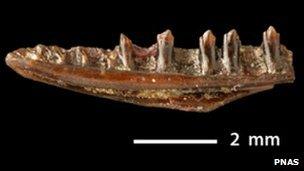Obama-named lizard was wiped out with the dinosaurs
- Published

Researchers say the giant extinction event that saw the end of the dinosaurs also killed off most snakes and lizards - among them a newly discovered species named after US President Barack Obama.
The effect of the event on dinosaurs is well known, but the fates of smaller creatures have been less certain.
Now, a rich record of reptile fossils - including the new Obamadon gracilis - suggests 83% of snake and lizard species became extinct at that time.
The study appears in the journal PNAS.
In it, researchers from Harvard and Yale universities in the US name eight more lizard and snake species that are new to science.
Obamadon gracilis was a tiny lizard that draws its name also from the Latin "-odon" meaning tooth and "gracilis" meaning slender.
Lead author of the study Nicholas Longrich, of Yale University, said there were no political undertones in the choice of name.
"We're just having fun with taxonomy," he said.
Besides bringing new species to the textbooks - and relegating them immediately to the "extinct" category - the study sheds new light on the extinction event, widely thought to have been caused by an enormous asteroid impact at the end of the Cretaceous period, about 65.5 million years ago.
Dr Longrich said that it had affected every ecological niche on Earth.
"The asteroid event is typically thought of as affecting the dinosaurs primarily," he said.
"But it basically cut this broad swath across the entire ecosystem, taking out everything. Snakes and lizards were hit extremely hard."
The study hinges on the analysis of existing fossils found in western North America, from Canada through to the south-west of the US, where the fossils of small reptiles are much better preserved than in other parts of the world.
The specimens were determined to range from tiny lizards such as O. gracilis, to snakes as large as a modern boa constrictor, to meat-eating lizards up to 2m (6ft 6in) long.
"Lizards and snakes rivalled the dinosaurs in terms of diversity, making it just as much an 'Age of Lizards' as an 'Age of Dinosaurs,'" Dr Longrich said.
- Published21 September 2011
- Published5 April 2011
- Published13 October 2011